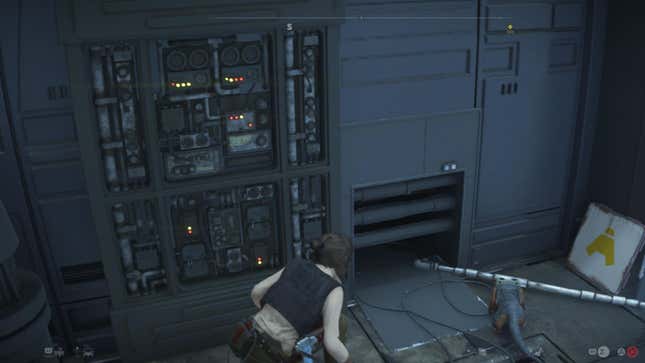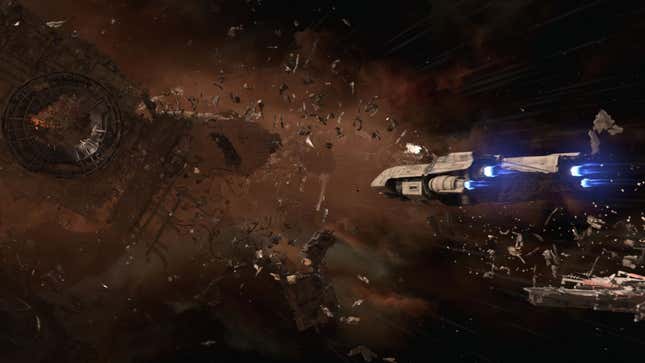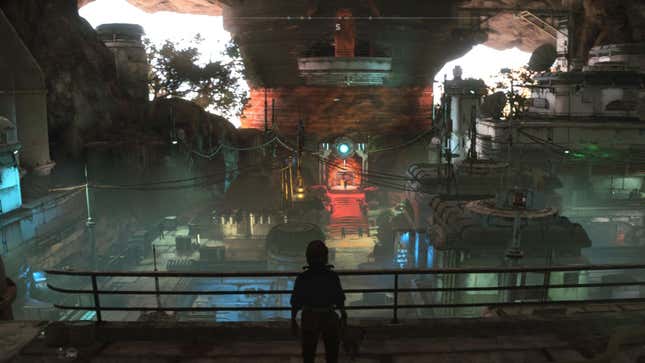I was staring at a wall. It was an early mission in Ubisoft’s latest gigantic RPG, Star Wars Outlawswhere I was tasked with breaking into an Imperial base to retrieve information from a computer, and this wall really caught my attention.

It was a perfect wall. It captured the late ’70s sci-fi aesthetic perfectly, with dark grey panelling punctuated by utilitarian grey panels covered in dim blinking lights, and I paused to think about how much work must have gone into that wall. When I looked elsewhere on the screen, I was blown away. That wall was the most boring thing in a massive hangar where TIE fighters hung from the ceiling, stormtroopers wandered in groups below, and even the little white sign with the yellow arrow looked like it was ten years old and carefully designed to fit into this universe. I was just amazed at the achievement. Ubisoft, with the help of multiple studios around the world and the work of thousands of extremely talented people, had created this impossibly perfect area for a single scene that I was simply supposed to walk past.
However, I ran past it three times because the AI kept messing up and I kept restarting at a checkpoint right in front of the gray wall.

I struggle to describe the dissonance of that moment. That feeling of absolute awe, of almost incredulous admiration that it’s even possible to make games at this scale and with this level of detail, is slapped hard in the face by the astonishingly bad decisions being made along the way.
When you’re excited about a beautifully designed wall, you’re setting yourself up for an aneurysm when you start noticing the tiny, changing details in characters’ faces or the meticulous animations of a bored security guard. Then, when I tried to imagine that the same care was applied to thousands of locations in multiple cities on a handful of planets, what I was really thinking was, “It’s ridiculous that we’re judging these games by the same criteria as others.” How can anyone TheThe majestyand say, “Hmmm, seven out of ten?” And then a security guard sees me through a massive mountainside, ruining fifteen minutes of painstaking stealth, and I wonder how this is even for sale.
In 2024, we’re at a very special point: AAA games are achievements that humanity would once have recognized as true wonders, and yet they play with the same irritating problems and boring repetitions as they did in the ’90s. This contrast, this dissonance, is absolutely fascinating.

Ubisoft seems to be the leader in this bizarre field. I have been amazed and baffled for years by what this company can create. although often not in a positive sense. The Assassin’s Creed series routinely builds entire cities, even countries, in authentic detail, to the point where we almost take it for granted. It always struck me as the most terrible waste that a game like Assassin’s Creed Odyssey can recreate ancient Greece in such wonderful detail and then it’s thrown away, and that entire digital space is never used for anything else again. It could be given to the world, offered up as the setting for a thousand indie games, and reused and recycled as such a feat deserves. Instead, it’s there for that one game where we’ll reasonably complain about the frustrating details of a failed quest or how the crowd AI fails at crucial moments.
And that’s just a small part of the art and architecture. We’re not even mentioning the fantastic script, the exquisite voice acting, the sound effects, the score, the lighting, the concept art that makes such designs possible, and the direction and leadership that can bring all of these disparate pieces together. All as a backdrop to me replaying the portal run because a remote AI decided to be triggered by a Nix it couldn’t possibly see, or because that time I pressed the square key it decided to throw a punch instead of triggering a takedown.

I’m old enough to remember a time when we used to complain that a beautifully drawn point-and-click adventure game wasn’t fun, and were so disappointed that such beautiful artistic skill was used as a backdrop for illogical puzzles and bad writing. Imagine if the camera shot from that adventure game showed the room it’s in, the house that room is in, the town that house is in, the city that town is part of, and the country that town is in – that’ll get you pretty close to the extent to which the same problem plagues us 40 years later.
This opening city alone in Outlaws, Mirogana, is more than gaming could do ten years ago, let alone 40. It alone would be enough for an entire game, with plot, missions, and characters. And it’s just a small blip in the overwhelming breadth of this game. I can’t stress enough the magnitude of what’s on offer here, and how incongruous it feels that all of this can be so easily dismissed in the face of such fundamental flaws. Flaws that cause the game to garner headlines like “Star Wars Outlaws Is too simple for its own good.” And I get it! I know what the article means! It is true that camouflage is banal and poorly implemented, and yet it is such a central element of the game. But damn, why can we reasonably say this creation “simple”?
I have no idea what the solution might be, but I have a feeling it lies somewhere in a new order of priorities. One that involves scaling back the ambition of everything a large-scale developer knows. may and concentrates its resources on fixing the absolute basics that are so often not achieved. Because the tragedy of a work of art like Outlaws— or any number of other architectural masterpieces that come and go in this industry every month — can be laughed at with a (deserved) 7/10 is just too awful.
Read more: Star Wars Outlaws: The My city review
At Gamescom this year, I heard a talk (currently under wraps) about how wind will make a game’s world behave differently. On the one hand, it was incredible, a technological marvel. On the other hand, it will be absolutely Nothing if the game’s basic loops are boring or the enemy AI endlessly runs into beautifully rendered walls. It could end up being a 7/10 game with technologically amazing wind.
And so I come back to that wall. And I thank everyone who was involved in making it so special, the artists who spent so much time making it feel authentic, the level designers who placed it, the people who were responsible for collision detection and made sure I couldn’t walk through it, the people who programmed the Snowdrop engine so that it could even exist, the producers who encouraged the developers who implemented it, and every single person who was in any way responsible for me creating that wall that I was able to stare at briefly. And I wish I hadn’t had to sneak past it. quite so often.
.



